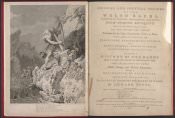The Bard Weaving Edwards Fate (Design 55)
between 1797 and 1798
William Blake
1757–1827
Watercolor with pen and black ink, graphite and gouache on moderately thick, slightly textured, cream wove paper with inlaid letterpress page
16 1/2 x 12 3/4 inches (41.9 x 32.4 cm)
Thomas Gray’s poem “The Bard,” published in 1757, imagines a confrontation between the English conqueror Edward I and the last bard of Wales. Edward has ordered the Welsh bards put to death in order to suppress their telling of history. The Bard curses Edward and prophesies his ultimate defeat upon the return of Welsh rule, before throwing himself into the river Conway, a final act of defiance. The poem became extremely popular, helping to create an idea of Welsh mountains as synonymous with liberty.
In 1797 and 1798, the visionary artist William Blake created a series of exquisite illustrations to accompany Gray’s text. Some of the most vivid images highlight the narrative trajectory of the poem. The title page presents a composed Bard, draped in robes and holding his harp. As the poem progresses, the Bard develops a frenetic energy, his hair wild and his eyes lit with passion. The final page shows the Bard, barely colored, almost a force of nature, committing suicide in the Conwy.
B1992.8.11(28)
Inscribed in black ink upper right: "3"; in graphite upper center: "+ +"; on verso in black ink upper left: "4"; in graphite upper center: "2 x"; in graphite center: "1 X"
Lettered on inlaid page:
"THE |
BARD. |
A PINDARIC ODE. |
I. 1. |
'RUIN seize thee, ruthless King. |
'Confusion on thy banners wait; |
'Tho' fann'd by Conquest's crimson wing, |
'They mock the air with idle state! |
'Helm, nor Hauberk's twisted mail, |
'Nor even thy virtues, Tyrant, shall avail |
G3 'To";
Lettered on verso, on inlaid page:
"96 THE BARD. |
'To save thy secret soul from nightly fears, |
'From Cambria's curse, from Cambria's tears!' |
Such were the sounds that o'er the crested pride |
Of the first Edward scatter'd wild dismay, |
As down the steep of Snowdon's shaggy side |
He wound with toilsome march his long array. |
Stout Glo'ster stood aghast in speechless trance! |
To arms! cried Mortimer, and couch'd his |
quiv'ring lance. |
I. 2. |
On a rock, whose haughty brow |
Frowns o'er old Conway's foaming flood, |
Robed in the sable garb of woe, |
With haggard eyes the Poet stood; |
(Loose his beard, and hoary hair |
Stream'd, like a meteor, to the troubled air;) |
And with a master's hand, and prophet's fire, |
Struck the deep sorrows of his lyre. |
'Hark,"
Yale Center for British Art, Paul Mellon Collection






